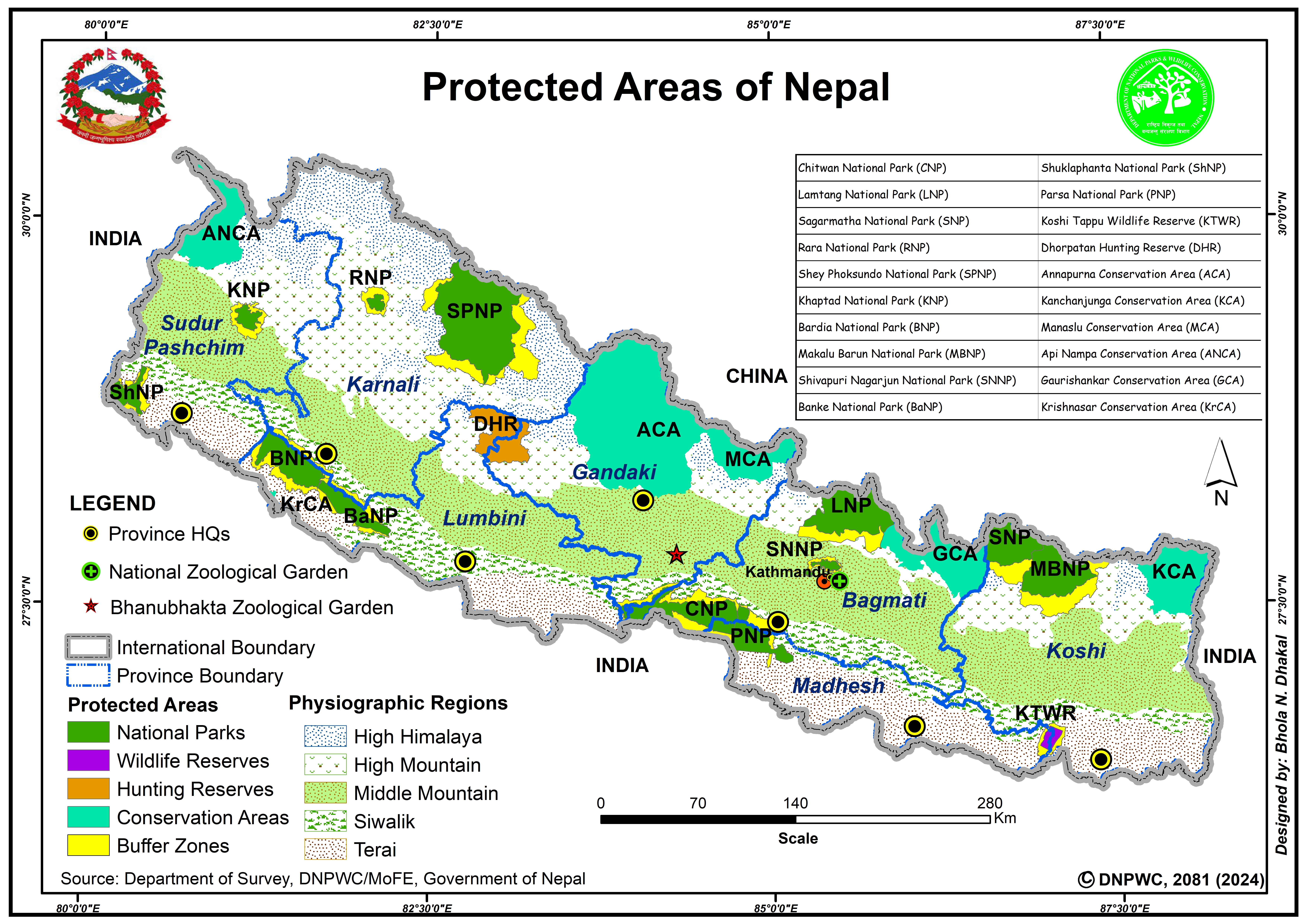Monday, January 20, 2025
Protected Areas of Nepal: Key Facts and Features
According to Economic Survey 2022/23, Until the mid-March of 2022, there are 12 national parks, 1 wildlife reserve, 1 hunting reserve, and 6 conservation areas, totaling 20 protected areas in Nepal constitution 23.4% of the total land area of Nepal.
Oldest National Park (NP) - Chitwan NP (952.63 sq km)- 2030 BS
—--2031 - shuklaphanta NP
—------2032 - Langtang NP; Sagarmatha NP ; Rara NP, Bardia NP
Largest NP - Shey Phoksundo NP - 2040 BS - 3555 sq km;
—-----Followed by Langtang NP: 1,710 square km,
—------------Makalu Barun NP: Encompassing 1,500 square km,
—------------------Sagarmatha NP: extends over 1,148 square km.
—------------------------Bardia National Park: 968 sq km
Smallest National Park - Rara NP - 106 sq km
—----To biggest Shivapuri NP 159 sq km
—---------------Khaptad NP - 225 sq km
—----------------------Shukaphnata NP 305 sq km
—------------------------------Parsa National Park: 627 square km,
—-----------------------------------Banke National Park: 550 square km
Recent date: Bank NP - 2067 BS
—2058 Shivapuri NP
—---2049 Makalu Barun NP
—-----2042 khaptad NP
—--------2040 shye phoksundo / Parsa NP
2044 - dhorpatan hr
Conservation area (CA) - largest to smallest -
------>Annapurna CA (7,629 sq. km)
-------------->Gaurishankar CA (2,179 sq. km)
------------------->Kanchenjunga CA (2,035 sq. km)
------------------------->Api Nampa CA (1,903 sq. km)
------------------------------>Manaslu CA (1,663 sq. km)
--------------------------->Blackbuck CA (16.95 sq. km)
2032 - Koshi tappu wildlife consrv.
-----------2049 - annapurna ca
--------------------2054 - Kanchenjunga ca
----------------->2055 - manaslu
------------------->2065 - krishnasar
2066 - gauri shankar
2067 - api nampa
| Protected Area | Established | Area (sq. km) | Location | Notable Features |
|---|---|---|---|---|
| Annapurna Conservation Area | 1992 (2049 BS) | 7,629 | Kaski, Lamjung, Myagdi, Mustang, and Manang districts | Largest conservation area in Nepal |
| Api Nampa Conservation Area | 2010 (2067 BS) | 1,903 | Darchula district in Province No. 7 | Located in the far west of Nepal |
| Krishnasar Conservation Area | 2009 (2065 BS) | 16.95 | Khairapur area of Bardiya district | Protection of blackbuck in natural habitat |
| Kanchenjunga Conservation Area | 1997 (2054 BS) | 2,035 | Northern Taplejung district | Rusty-bellied frog and Paha Blanford species |
| Gaurishankar Conservation Area | 2010 (2066 BS) | 2,179 | Borders Sagarmatha and Langtang National Parks | Located near Tibet’s autonomous region |
| Manaslu Conservation Area | 1998 (2055 BS) | 1,663 | Gorkha and Manang districts | Promotes biodiversity conservation |
| Dhorpatan Hunting Reserve | 1987 (2044 BS) | 1,325 | Rukum, Baglung, and Myagdi districts | Nepal's only hunting reserve |
| Khaptad National Park | 1984 (2042 BS) | 225 | Bajhang, Bajura, Doti, and Achham districts | Spiritual significance, biodiversity conservation |
| Chitwan National Park | 1973 (2030 BS) | 952.63 | Chitwan, Makwanpur, Parsa, and Nawalparasi districts | UNESCO World Heritage Site, one-horned rhinos, and Bengal tigers |
| Parsa National Park | 1984 (2040 BS) | 627.39 | Chitwan, Makwanpur, and Parsa districts | Rich biodiversity and natural habitats |
| Bardiya National Park | 1976 (2032 BS) | 968 | Bardiya district | Karnali and Babai rivers; home to nilgai and tigers |
| Banke National Park | 2010 (2067 BS) | 550 | Banke, Dang, and Salyan districts | Established for tiger conservation |
| Makalu Barun National Park | 1991 (2049 BS) | 1,500 | Borders Sagarmatha National Park to the west | Sacred Himalayan landscape; links with Kanchenjunga Conservation Area |
| Rara National Park | 1976 (2032 BS) | 106 | Mugu and Jumla districts | Home to Rara Lake, Nepal’s largest freshwater lake |
| Langtang National Park | 1976 (2032 BS) | 1,710 | Rasuwa, Nuwakot, and Sindhupalchok districts | Red pandas, Gosaikunda Lake, and Kyanjin Gompa |
| Shivapuri Nagarjun National Park | 2002 (2058 BS) | - | Chisapani to Kakani | Source of the Bagmati River |
| Shuklaphanta National Park | 1976 (2031 BS) | 305 | Kanchanpur district | Largest grassland (54 sq. km) and Rani Tal |
| Shey-Phoksundo National Park | 1984 (2040 BS) | 3,555 | Dolpa and Mugu districts | Nepal’s largest national park, includes Phoksundo Lake |
| Sagarmatha National Park | 1976 (2032 BS) | 1,148 | Khumbu region of eastern Nepal | UNESCO World Heritage Site, home to Everest and Dudh Koshi River |
| Koshi Tappu Wildlife Reserve | 1976 (2032 BS) | 175 | Sunsari and Saptari districts | Protects the wild water buffalo (Arna) |
Saturday, April 25, 2020
National Park of Nepal
(the International Union for Conservation of Nature (IUCN), and its World Commission on Protected Areas (WCPA), has defined "National Park" as its Category II type of protected areas. According to the IUCN, 6,555 national parks worldwide met its criteria in 2006. IUCN is still discussing the parameters of defining a national park)
Chitwan National Park
Established: 2030 /6/04
Sagarmatha National Park
Established: 2032 /12/09
Area: 1148 Sq.km
Established: 2032 /12/09
Area: 1740 Sq.km
Shey Phuksundo National Park
Established: 2040
Area: 3555 sq.km
Khaptad National Park
Established: 2042
Banke Natrional Park
Established: 2067
Shuklhaphata national Park
Established: 2073
Parsa National Park
Established: 2074
Saturday, November 16, 2019
Makalu Barun Conservation Area
An international organization conducted study about the biological richness, in 1980s. Makalu-Barun Conservation Area Project was start with collaboration with Department of National Parks and Wildlife Conservation and The Mountain Institute.
Makalu Barun was programmed as a Strict Nature Reserve, one of the type in Nepal to conserve ecosystems. In 1999 it was converted into a buffer Zone under the Buffer Zone Management Guidelines.
Established: 1991 ( 2049 BS)
Area: 1500 sq.km
Source: DNPWC
